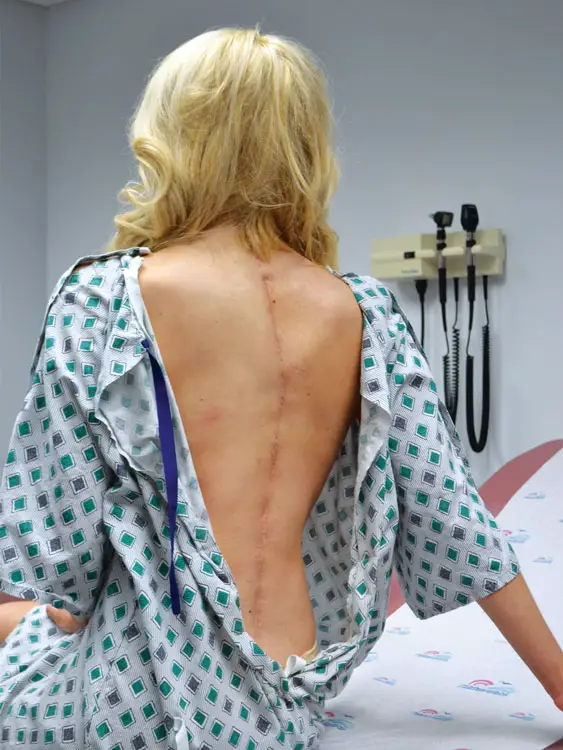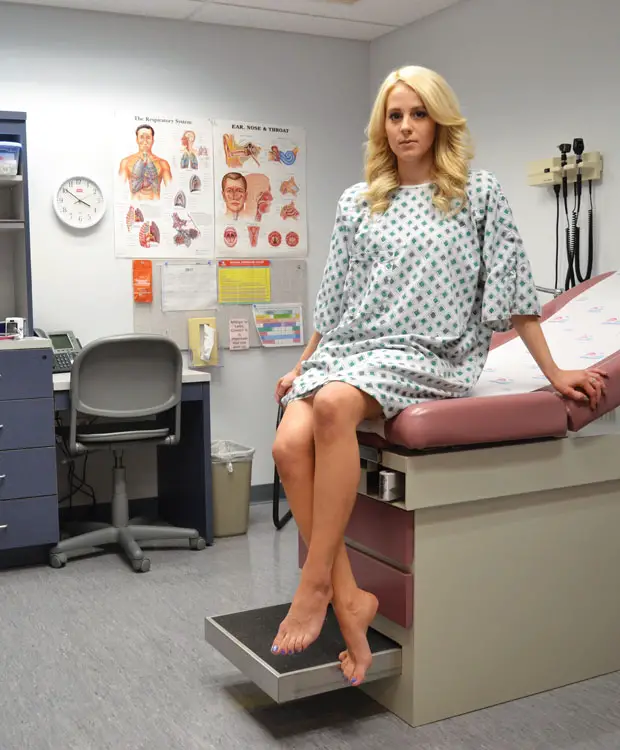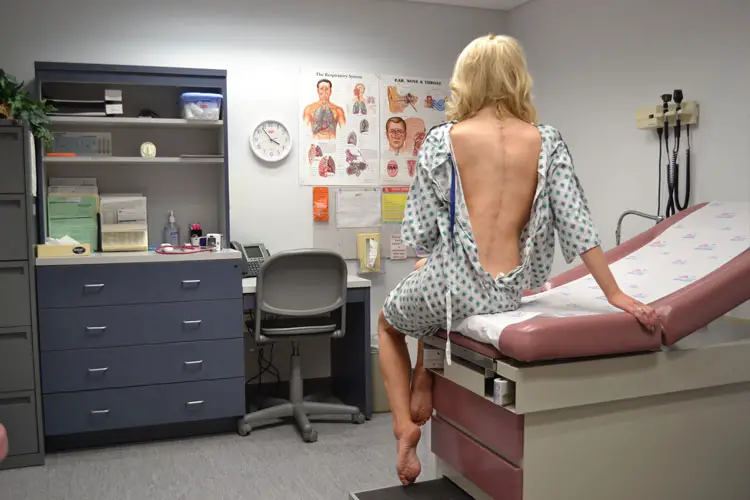Looking at Victoria Graham, you would never guess that there is anything unusual happening within her body. The Mount St. Mary’s University student, who competes in beauty pageants and recently won a prominent local competition, looks no different standing on stage next to the other equally talented, beautiful women, and you would never guess something was wrong—until she turns around.
Graham has Ehlers-Danlos Syndrome (EDS), an illness that weakens the tissue of the skin and bones, affecting every aspect of her body, and causing hyper-flexibility, dislocation of joints and constant pain. This illness left her with a twenty-five-inch scar that spans the length of her spine. With no way to hide the scar, she walks across the stage during pageants in bikinis and backless dresses. For the talent portion, where she performs a monologue designed to educate her audience on EDS, Graham dons a tailored hospital gown, leaving her back exposed.

Though she is proud to show her scar now, Graham was not always this comfortable with her illness. As a child, she was an athlete, playing soccer and competing in gymnastics. Though she did not have an official diagnosis, Graham did know that her joints would dislocate. Despite this knowledge, she refused to wear braces on her knees, even during her games, because she was scared of what others would say. Arriving at her first pageant audition, wearing a thrift store t-shirt and a neck brace accompanied by her dad, she was still self-conscious. She looked around at the other women and thought, “What am I doing here?”
Graham made the decision to compete in a beauty pageant after a late-night conversation with her roommate. “Sports had been taken from me. Most of my social life had been taken from me. I was on a reduced course load, so school had been taken from me. So many aspects of my life had been changed in ways that I had no control over, so I wanted to do something for me while I still had the ability,” she says.
A photographer taking headshots of the contestants questioned her about her illness, and when Graham reached to take off her neck brace for the picture, the photographer insisted that she keep it on. “That was one of the first pictures of myself I ever really liked,” she says. “I began to realize that I could still like how I looked with a neck brace on.”
After this first experience with a public display of her illness, outside of posting on social media for her family, EDS became a focal point of her pageant platform. She created an awareness campaign called “But You Don’t Look Sick,” which sheds light on invisible illnesses, or chronic conditions that show no outward symptoms.
Wanting to take this awareness to an even grander scale, for her twenty-second birthday, Graham founded a non-profit organization called The Zebra Network. The organization takes its name from the common physician’s approach to medical problems. They are taught to always think of the obvious answer first, to think of horses when they hear hoofbeats. Graham hopes her organization can change this. “When you hear hoofbeats, think zebras because zebras exist,” her website displays.
The Zebra Network works not just to educate the public on Ehlers-Danlos Syndrome, but to provide advocacy to victims. When Graham was a child and began regularly visiting the doctor, she spent an awful amount of time in waiting rooms. She would sit in these rooms, dreaming of ways they could be better. “We would have a wall where people could paint, an area where people could do crafts or watch TV, all of the things that would make the situation better in a child’s mind.”
Her childhood imagination was the inspiration behind her non-profit, which works to make hospital stays better for not just the patients, but the caregivers as well. When someone with EDS stays in the hospital, there must be someone with them at all times to monitor movement. “The caregiver can’t even leave the room to go get lunch in the cafeteria,” Graham says.
The Zebra Network, in addition to raising awareness of EDS, provides care and support baskets to hospital caregivers. Graham places so much importance on the education of invisible illnesses, because she wasn’t able to get her own diagnosis until she went to college. From the ages of ten to thirteen, Graham and her family were actively seeking the reason for her pain, going from doctor to doctor, desperate for a diagnosis. “Some of them questioned my sanity,” Graham says. “They wanted to know if I had friends, if I was happy. Some of them said I was making it up, that the amount of pain I said I was in wasn’t really what was going on.” This is a common issue for those who suffer from illnesses that disguise themselves. Because there is no bandage to see or cast to sign, because the illness is harder to understand, there is a tendency to dismiss it all together.

It wasn’t until almost ten years later that she was finally given an answer. Graham was in organic chemistry class, listening to her professor’s lecture, concerned with passing the class to satisfy one more item on her Pre-Med Biology checklist, when she experienced sudden memory loss. She didn’t know where she was. She didn’t even know who she was.
Her memory returned, but her health concerns persisted. It wasn’t until a week later when she was studying for a quiz and, again, her memory failed her, that she finally allowed herself to worry. This time, she couldn’t retain any information, and, after having a photographic memory for most of her life, she knew something was wrong.
She called her parents, panicked and was instructed to get ready because they were taking her to the doctor’s. “But you don’t understand,” she said, “I have a test tomorrow.” Many college students, like Graham, have had to decide what takes priority when, alongside final exams and group projects, you are also dealing with a chronic illness
So, after seeking medical attention for her memory loss, Graham took a semester off from college, Eastern College at the time, to seek out a specialist. There she received disheartening news. “One of the specialists, the head of a headache clinic at a world-renowned hospital, told me that there was no mechanical reason for my pain,” she says.
After finally seeing an Ehlers-Danlos specialist, she found out there were actually seven mechanical reasons for her pain. The doctor who originally told her there was nothing wrong later said he had seen thirty possible EDS patients, but had neglected to diagnosis any of them. “My immediate reaction was, ‘What about the 29 other people? Where are they now? Are they even alive?’” she says. “It was infuriating.”
She was able to go back to school, but it wasn’t long before she felt the symptoms again. After seeing her neurologist, she discovered that her vertebrae were loose, hitting nerves, arteries and her spinal cord. She took her finals early that semester and, while everyone else were slaving away over their tests, Graham was having surgery. She began a constant cycle of having surgery and going to school, eventually taking a total of a year-and-a-half sabbatical in which she had six different surgeries.
During her time at Eastern College, Graham says that there were certain members of the administration who were great, but there were certain people, namely professors, who weren’t considerate. Ecology was a class that she needed to take for her major, but she found herself in a bind when, despite having the American Disabilities Act, a Disabilities and Accommodations coordinator and the head of the Biology department on her side, a professor would still not let her take his class. “It was because I couldn’t participate in a kayaking trip,” she says. “He said he didn’t understand because there was a student last semester in a wheel chair and she was fine.”
Graham suspected that the professor’s obstruction was due to the invisibility of her illness and his lack of understanding. A reason, she says, she encourages college students to talk with their professors and peers, to facilitate awareness. “So many professors do care about you, and they’re willing to listen. You just have to be honest with them.”
Not only can the education of these illnesses help administrators better accommodate their students, but it can help students seek assistance in the first place. Because these illnesses don’t outwardly show symptoms, many students brush their health to the side, either underestimating the severity of their condition or not being comfortable initiating the conversation.
This phenomenon is most prominently seen with mental illnesses. “20-25 percent of college students struggle with a mental illness in a given year,” Maggie Bertram, associate director of training and education for the Active Minds organization, says. “Of those students, less than half seek any kind of professional help.”
Some of this disparity can be explained by a perceived stigma attached to mental illness. Many students are simply just too embarrassed to talk about it. “People don’t want to talk about their struggles, because they either don’t recognize why they’re struggling or they’re afraid people will judge them for it,” Madalyn Purcell, founder and editor of “Mentality Magazine,” says. “A lot of the confusion and the misunderstanding that people have about mental health is because it is not often a topic that is openly discussed in society. But it should be.”
“Mentality Magazine” is a student publication at the University of Michigan focused entirely on mental health, publishing the stories and experiences of students. The goal of the magazine is to educate and encourage discussion on the U of M’s campus, and provide those who suffer in silence a place for their voices to be heard. “I think everyone should be informed about mental health because your mindset, your mentality, that is you,” Purcell says, “and if you lose track of it, you lose a part of yourself.”
Acknowledging that there is an issue in the first place can be a struggle in its own right. “There are things that I need to admit that I can’t do,” Graham says, “and it’s embarrassing sometimes, and I feel guilty for it, to say that I need help.” For a while, she would never accept accommodations from the university because she didn’t want to look different or have others assume she was being granted special treatment. Looking back now, Graham would urge everyone to take any extra help they can get. “One day you could be okay, but the next quiz you might need them. I definitely struggled with that. It’s tough to admit to yourself that you need help.”

Though seeking out these opportunities is the best course of action, there are situations that make starting these conversations difficult and, frankly, pretty awkward. “I took a five-week philosophy class; each class was four hours long and I have a neurogenic bladder, meaning there’s nerve damage from where my spinal cord was tethered to my spine,” Graham says. “I pee often. I had to get up six times in one class period.”
The idea of discussing her restroom habits with her fellow classmates was embarrassing for Graham, and many of those who battle invisible illnesses find themselves in similar situations. Kelly Green, a student at Cuesta College, deals with vaginismus, a condition wherein her pelvic muscles contract and never release, making menstruation painful, sex impossible and even the act of putting on pants, at times, unbearable. “One can’t exactly discuss their vaginal health with a professor, so, to those who say, ‘Just explain it,’ it’s not always that simple,” Green says.
Her illness interfered with her education, limiting the amount of energy she had to contribute to her school work. She ended her first semester having only completed four credit hours. “It’s incredibly demoralizing to feel you’ll never be fully human and that no one understands,” she says.
In order to allow for the possibility of these kinds of conversations, awareness of illnesses that aren’t easily recognizable is necessary. Organizations like “Mentality Magazine” and Active Minds are providing students with the tools to discuss mental health. “By opening up conversations about mental health on campuses, Active Minds chapters are dispelling some of the most common myths about help-seeking, so that more of their peers will get the assistance they need before reaching a crisis point,” Bertram says.
Similarly, the Zebra Network has been able to reach an audience that extends beyond the United States. “I recently received an email from a woman in Venezuela, and, after somehow ending up on the French evening news, I now get messages from France saying they need my help,” Graham says. “But I’m only one person and sometimes I don’t know what to do.”
Graham, on top of competing in beauty pageants and working with her non-profit, has returned to taking classes at Mount St. Mary’s University, something that she loves, but that is heavily affected by her illness. Completing her work now takes tremendous effort and long hours after suffering the equivalent of a traumatic brain injury. “To complete one chapter takes me a couple hours to read through. Then I have to take notes and then reread through the book one more time. That can take me six hours just to do that.”
She does this all knowing that, at any time, more issues can crop up. Some days she’s paralyzed, and some days routine checkups turn into emergency surgeries. Just before our interview, she had an emergency procedure, and yet, the meeting was pushed back only two hours, and she still enthusiastically answered questions on the phone, going on with business.
Graham’s passion for her education, her business and her life are what carry her to completing her tasks and what sometimes help her just to get up in the morning. “I just do it,” Graham says, “because this is what I have to do.”













Your story is inspiring. My friend has EDS and suffered for many years before she was finally diagnosed at the age of 34. People said she was a hypochondriac, lazy, a drug addict. Thanks for creating your organization and bringing more awareness!